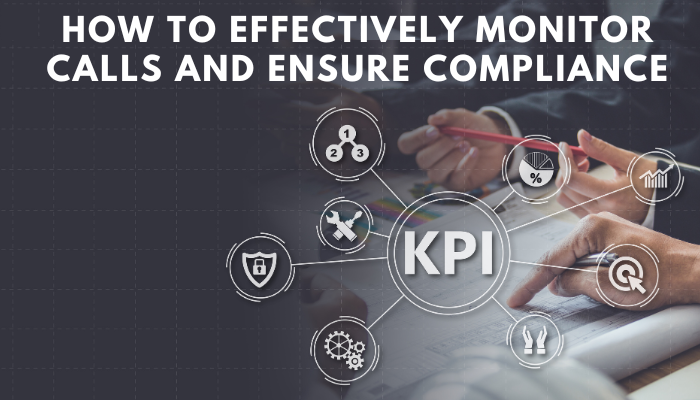
Navigating the Sound Waves: How to Effectively Monitor Calls and Ensure Compliance
June 21, 2023 Comment off
In an increasingly digital era, business communication channels have expanded to embrace a more global and connected world. Among the array of digital tools at our disposal, the good old-fashioned phone call remains one of the most popular. Although it seems simple, this mode of communication carries its own set of challenges, especially when it comes to monitoring calls and ensuring compliance. With evolving regulations and increased scrutiny, businesses need to proactively strategize their call monitoring techniques.
So, how do you ensure you are monitoring calls effectively and maintaining compliance? In this article, we’ll delve into the essentials of the process, from the technology required to the best practices for achieving maximum effectiveness.
1. Understanding the Importance of Call Monitoring
Call monitoring is an essential part of quality assurance in businesses, allowing managers to evaluate and improve their team’s customer service skills and ensure compliance with regulatory standards. Monitoring can reveal critical insights about customer interactions, help identify training opportunities, and improve overall service delivery.
2. Familiarize Yourself with Regulations
Regulatory compliance is a significant aspect of call monitoring. Different countries have varying laws and regulations regarding call monitoring and recording. Therefore, before implementing any monitoring, ensure you understand the legal framework around it. Notably, the two key laws in the U.S are the Telephone Consumer Protection Act (TCPA) and the Telemarketing Sales Rule (TSR).
In the EU, call recording is regulated under the General Data Protection Regulation (GDPR). These regulations stipulate that calls can only be recorded with the informed consent of both parties. Non-compliance can result in hefty fines, legal penalties, and reputational damage.
3. Choose the Right Technology
Implementing effective call monitoring relies on the right technology. This includes choosing a system that records calls, transcribes them, and offers features like keyword spotting and sentiment analysis. Many cloud-based solutions exist today that provide these features while integrating smoothly with existing infrastructure.
Choosing a system with artificial intelligence (AI) capabilities can provide further benefits. AI can analyze calls in real-time, identify regulatory compliance issues, and flag them for review. This not only saves time but also helps in catching potential compliance issues before they become problematic.
4. Develop a Monitoring Framework
Without a clear framework, call monitoring can become an aimless process. A well-defined call monitoring framework should detail who is responsible for monitoring, what they should be looking for, and how often monitoring should occur.
An effective framework includes defining key performance indicators (KPIs) that reflect your business goals. These could be metrics like average call duration, first call resolution rate, or customer satisfaction scores. Monitor these metrics consistently to gauge performance and identify areas of improvement.
5. Train Your Team
Your team should understand the purpose and process of call monitoring. Provide comprehensive training, emphasizing the importance of compliance. Clear communication about what is being monitored, why, and the implications of non-compliance is crucial.
6. Regular Reviews and Feedback
Monitoring alone is not enough. It’s essential to share feedback with your team regularly to improve their performance and adherence to compliance rules. Whether positive or negative, constructive feedback motivates employees to improve and can significantly boost morale and productivity.
7. Protecting Customer Data
With call monitoring comes the responsibility of safeguarding customer data. Strict data handling and storage procedures should be in place. Calls containing sensitive information should be stored securely and deleted in accordance with data protection regulations.
8. Review and Revise
As with any business process, it’s crucial to continually review and revise your call monitoring strategies. As regulatory landscapes and business goals change, so should your approach to call monitoring and compliance. Regularly assessing your monitoring practices helps you stay in tune with evolving requirements, ensuring you’re always ahead of the curve.
9. Utilize Analytics and Reporting
With the advancement of technology, businesses can harness the power of data analytics in call monitoring. Utilize your call monitoring software’s analytics and reporting capabilities to glean valuable insights about your team’s performance and customer satisfaction levels. Analyzing these reports will help identify trends, gaps, and opportunities for improvement.
10. Foster a Culture of Compliance
Lastly, fostering a culture of compliance is key to effective call monitoring. Encourage open communication about compliance issues and provide ongoing training to ensure everyone understands their role in maintaining compliance. Reward compliance and recognize employees who go above and beyond to adhere to rules and regulations.
Effectively monitoring calls and ensuring compliance can seem like a daunting task, but with a clear strategy and the right tools, it becomes an integral part of business operations. In addition to safeguarding against regulatory penalties, a solid approach to call monitoring can lead to improved customer service, greater operational efficiency, and ultimately, a more successful business.
Remember, monitoring and compliance are not about policing your employees, but rather about building a resilient and customer-oriented organization. With proper training, the right tools, and a culture that values compliance, you will navigate the choppy waters of call monitoring with confidence and competence. In a world that is increasingly connected and conversational, let’s continue to make every call count.